Alongside the B-17 Flying Fortress, the B-24 Liberator was one of the main American bomber types of WWII pending arrival of the B-29 to the Pacific theatre. Despite the huge number built, they disappeared with amazing quickness from the postwar American military, serving on only in China and India.

(The EZB-24 test plane which was the very last Liberator in the US Air Force.)

(Indian B-24 Liberator bomber.)
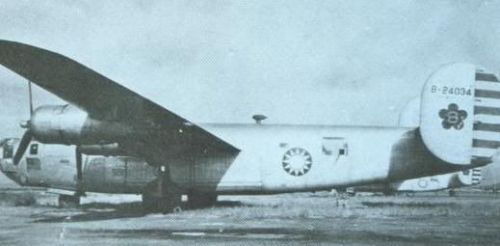
(Taiwanese B-24 Liberator bomber.)
B-24 Liberator: basic description
Consolidated’s 11-man B-24 Liberator strategic bomber of WWII was 67’2″ long with a 110′ wingspan, weighing 18¼ tons empty. It was powered by four Pratt & Whitney R-1830 Twin Wasp air-cooled piston engines, with a top speed of 258 kts and a laden cruise speed of 187 kts.
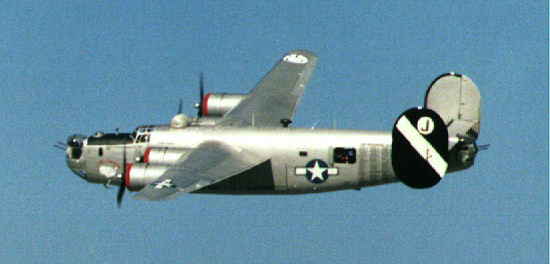
The Liberator could carry 8,000 lbs of bombs at a 400 mile range. With the warload cut to 5,000 lbs this range doubled, and with a minimal bombload (2,700 lbs) maxed out at 1,200 miles. The defensive armament was ten AN/M2 .50cal machine guns; four twin turrets and two open single mounts.
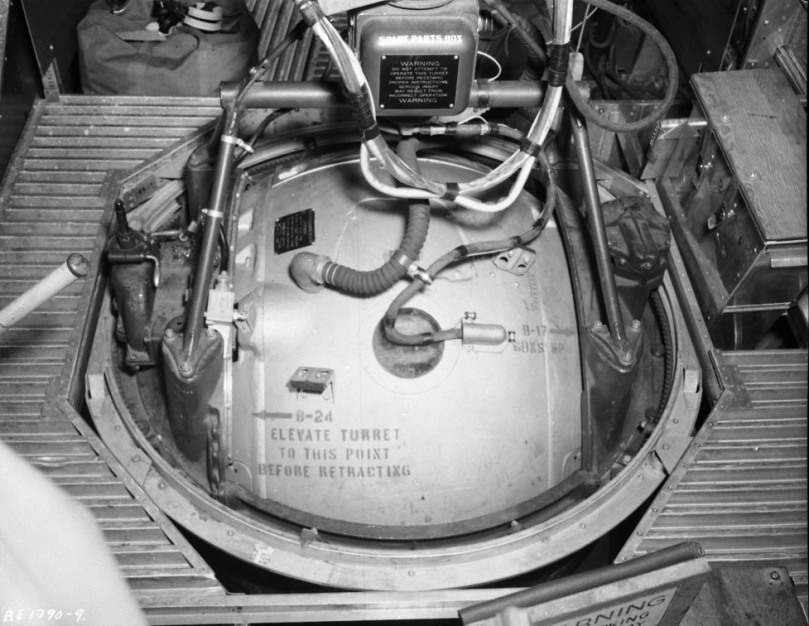
(The retractable ball turret on a RCAF Liberator. Along with the UK and Australia, Canada was one of the original non-American B-24 operators during WWII, joined later in the war by South Africa and nationalist China.)
Besides the baseline bomber, the airframe was the basis of the PB4Y-2 Privateer naval patrol plane (it actually had a longer post-WWII career) and the C-87 Liberator Express cargo plane. The Privateer was so different that it was effectively its own type.
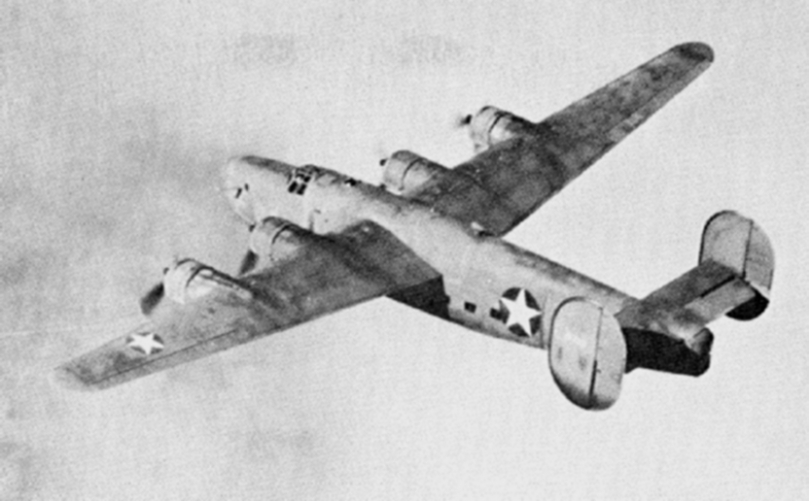
(C-87 Liberator Express during WWII)
The C-87 was rushed through development in 1942 to deliver a transport serving long-distance / high-altitude routes unsafe or impossible for the C-46 Commando and C-47 Skytrain. The front turret and bombardier position of the B-24 was replaced by a hinged aluminum cap for light cargo. The fuselage was modified with a metal floor over the former bomb bay, windows, and a 6’x6′ door. With this 6 tons of cargo or two dozen passengers could be carried.
Only 287 C-87 Liberator Expresses were built. They were important in the CBI theatre as they could fly fully-laden over the Himalayas. They had major problems however, the worst being sensitivity to the centre-of-gravity. Ground crews had to take extreme care in balancing the load; otherwise the C-87 would be nearly uncontrollable in the air; but this would not be known until the plane was airborne.
Production of the B-24 was by two Consolidated factories, a factory of the Ford automobile company at Willow Run, MI, and lesser licensed production by Douglas, Bell, and North American.
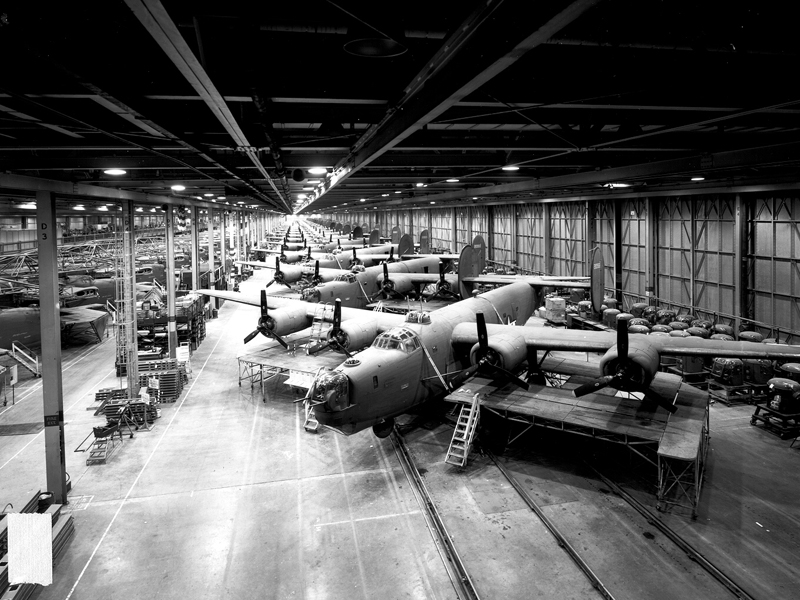
(Ford’s Willow Run B-24 assembly line during WWII. Production halted in May 1945 and no other warplane type was ever built there. After WWII the factory was converted to automotive use and passed from Ford to Kaiser and then to General Motors which shut it down in 2010. The factory airstrip is still in operation as of 2020 as the civilian Willow Run Airport.)
Compared to its WWII partner, Boeing’s B-17 Flying Fortress, the B-24 Liberator carried the same bombload but was 25 kts faster fully-laden; both having roughly equal range. Despite each costing about $59,000 more than a B-17, the government preferred the B-24 as it could be assembled quicker and with wider factory tolerances.
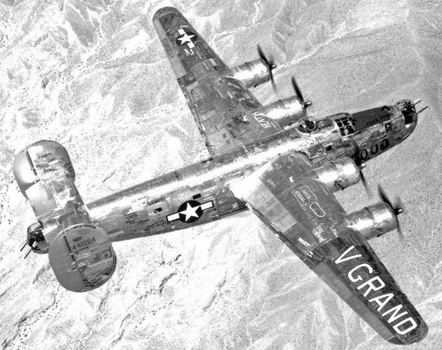
(“Five Grand” was the 5,000th Liberator and over 10,000 more were still to come.)
For certain the B-24 was a success but it did have some problems. The wingform, sometimes called the “Davis wing”, accumulated ice rapidly and even on its own, was a more challenging type to learn to fly. If given the choice, most WWII airmen preferred the B-17.
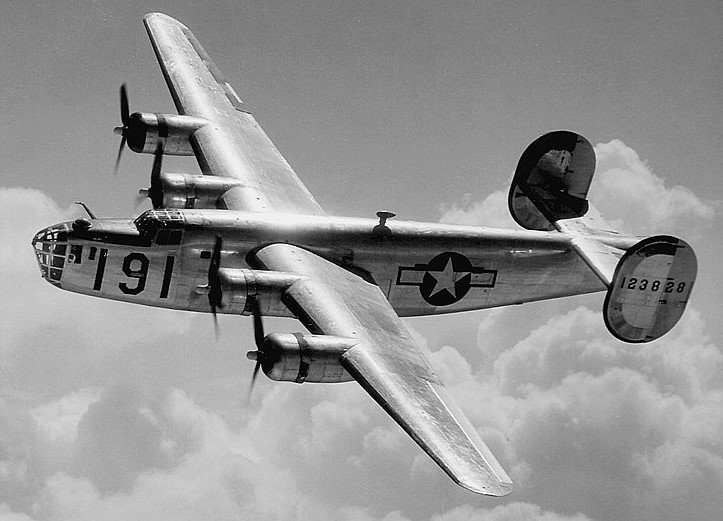
(Even before WWII ended, B-24s were being diverted to non-bomber roles. This unarmed B-24D Liberator served at Maxwell AFB, AL as a trainer for pilots destined to quad-engined types.) (US Air Force photo)
Overall B-24 Liberator production was 18,482 during WWII. The B-24 was not only the most-produced strategic bomber of any nation during WWII, but of all time. It is also the most-produced 4-engined plane (military or civilian) of all time and the most-produced design of the United States during WWII of any role.
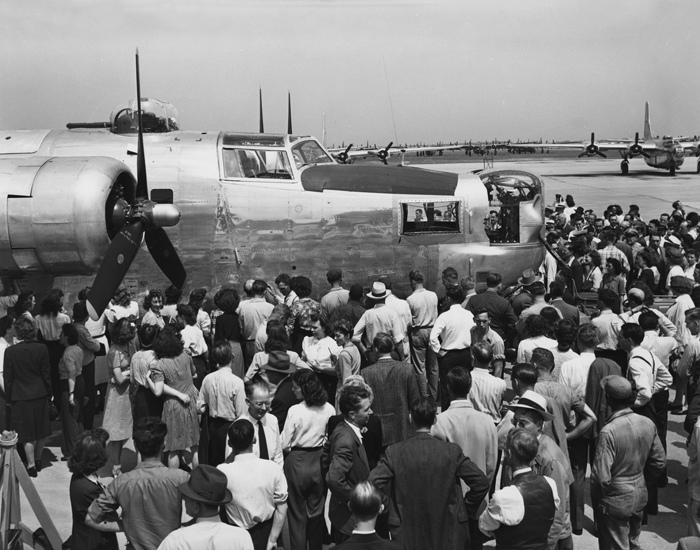
(On 28 June 1945 the final B-24 rolled off the assembly line. WWII would end about two months later. This airplane never served, it was flown as “terminal inventory” straight to Kingman, AZ for scrapping.) (photo via Ford Motor Company)
Despite these accolades the B-24 had a remarkably short career in the American military. The first production version planes were delivered in mid-1941. After Germany’s surrender in May 1945 the remaining 5,168 Liberators on order were cancelled. Of bomber squadrons operating B-24s when WWII ended altogether in September 1945, the first, the 814th, stood down a few days after Japan surrendered. The last Liberator bomber squadrons were in the US Army 5th Air Force which discarded the type in May 1946.
Thus the most-built American bomber of all time only served for 4 years, 10 months.
part I: the United States & wartime allies
When WWII ended in September 1945 the US Army’s air units (about to become the independent US Air Force in September 1947) had no interest in the Liberator. Like the B-17 Flying Fortress, the B-24 was considered “yesterday’s technology” and not desired for postwar use.
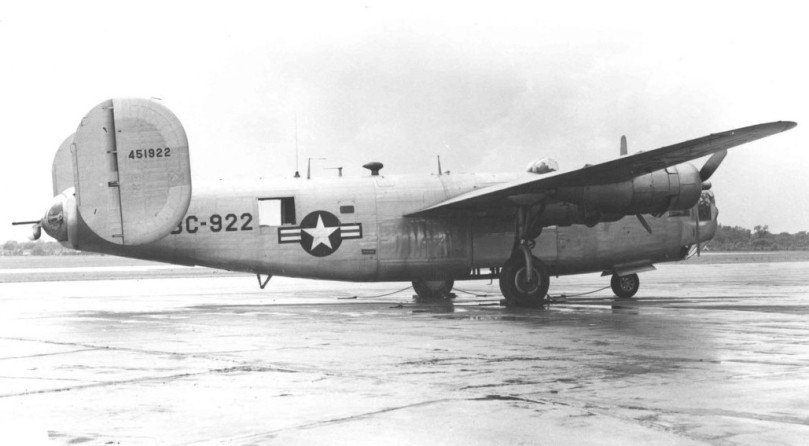
(This B-24M belonged to a 1945 production lot and had all of the wartime improvements, including the final lightweight tail turret. WWII ended before this plane was issued to a squadron.) (US Air Force photo)
During the final part of WWII, American strategic bombing doctrine shifted in favor of the very long ranged, high altitude missions flown by the B-29 Superfortress against Japan. The B-29 carried 12,000 lbs of bombs at a 1,200 mile radius; whereas the B-24 was limited to 2,700 lbs at that range. Even with that payload difference, the B-29 still had an extra 3,150′ of ceiling and was 50 kts faster. The B-29 could receive the “silverplate” modification for first-generation atomic bombs, while the B-24 (and the B-17) could not.
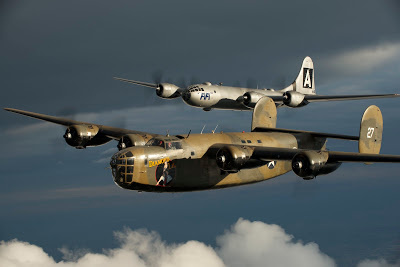
(B-24 and B-29 together.) (photo by Scott Slocum)
Considering the colossal numbers of B-24s in service on V-J Day, the speed with which the United States discarded the type is astonishing.
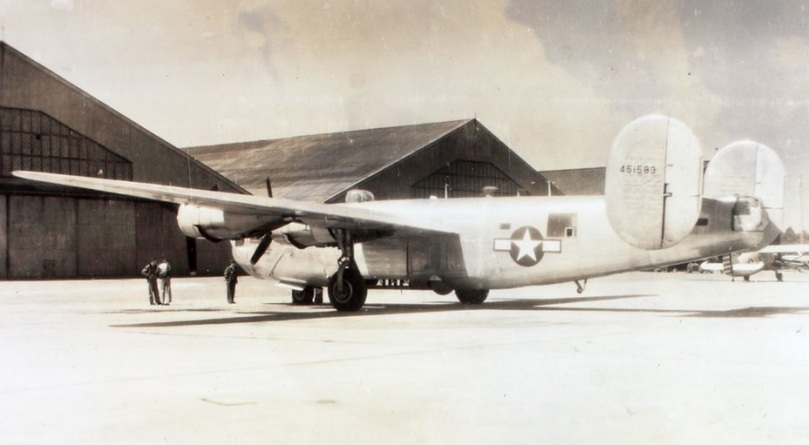
(It had been decided to convert some Liberators into FB-24 Ferret electronic warfare planes for the planned final invasion of mainland Japan. They were fitted with AN/APQ-13 and AN/APA-6 equipment. Only a handful were done when Japan surrendered and the project was cancelled. This one was photographed after WWII in occupied Japan.)
The final B-24 combat missions were flown in mid-August 1945. When WWII ended altogether in September 1945, entire bomber groups were either converted to B-29s or (more commonly) just disbanded.
By the end of 1945, four months after WWII ended, the vast majority of B-24 units had been stood down and flown to reserve lots. Of those that remained, little was being done. For example the 819th Bombardment Squadron, which had been based at Saipan during the Iwo Jima campaign, moved to Wheeler AFB, HI in March 1945 as remaining worthy targets were out of range. After V-J Day the unit moved to Kahuku, a temporary airstrip on Oahu, where there was realistically no infrastructure to support any type of operations. The squadron formally disbanded in November.
By early summer 1946, there was no longer any active-duty bomber squadron at all still flying a B-24. Less than a year earlier, there had been dozens of squadrons flying thousands and thousands of B-24s.
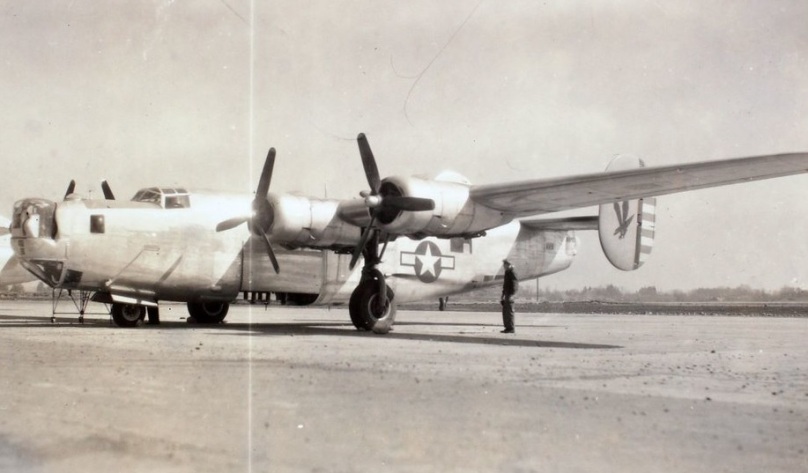
(A F-7 Liberator, the reconnaissance version, in occupied Japan after WWII.)
A few units flying the F-7 Liberator, the reconnaissance version, continued operating them through the summer of 1946. But by the end of the year, these were gone as well.
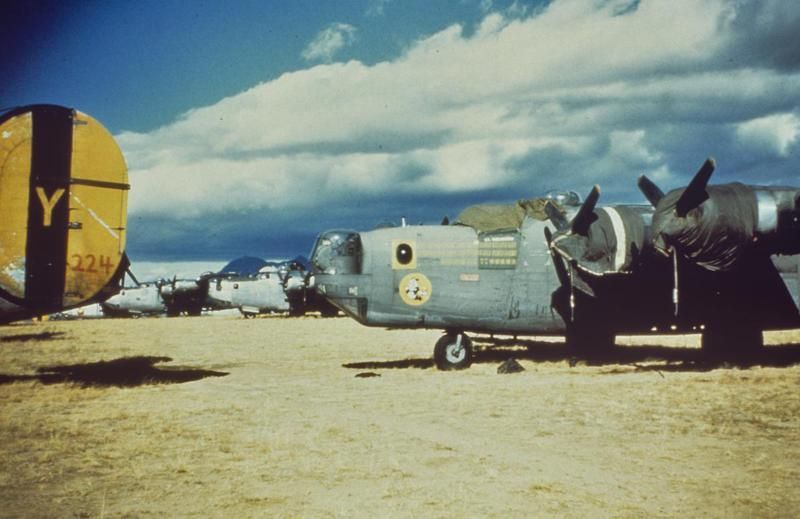
(B-24 Liberators at a lay-up lot near Sandia, NM in 1946, a year after WWII ended.)
Although the naval offshoot, the Privateer, had a decent post-WWII career with the US Navy and US Coast Guard, by 1946 there was no interest in keeping any of the thousands and thousands of B-24s, even in reserve. Nor was there any interest (except for a handful of planes) to adapt B-24s to second-line roles.
To begin with, the military saw them as a “block” opportunity to rid an entire type from the spare parts stream and training programs. Secondly, even as WWII ended, bomber technology was advancing greatly and having B-24s in reserve was considered a possible political funding threat to postwar designs.
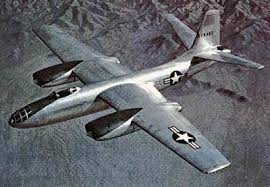
(Design of the B-45 Tornado, the first American jet bomber, started in September 1944 as American troops were approaching the German border. The prototype was ready in 1945 but the project was put on hiatus after V-J Day. In 1946 it was revived and a small production run was made in 1947.)
During the late 1940s a very small handful of Liberators soldiered on in the now-independent US Air Force, in secondary non-combat “odd job” roles.
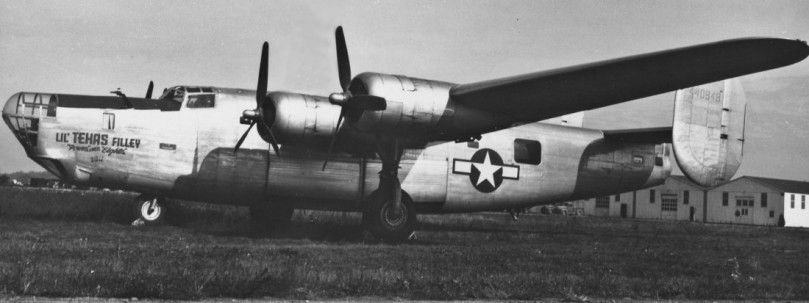
(This B-24J was disarmed for use as a staff shuttle briefly after WWII. The nose is not the standard no-turret “greenhouse” model nor the standard aluminum “cap” type, and may have been an ad hoc design by squadron mechanics.)
One, a B-24D used for technical research by the Sperry gyroscope company, was redesignated XB-24P and operated for a year or two in that role. One from the final 1945 Willow Run production batch was sent to the Northrop Aeronautical Institute in California for use as a training aid.
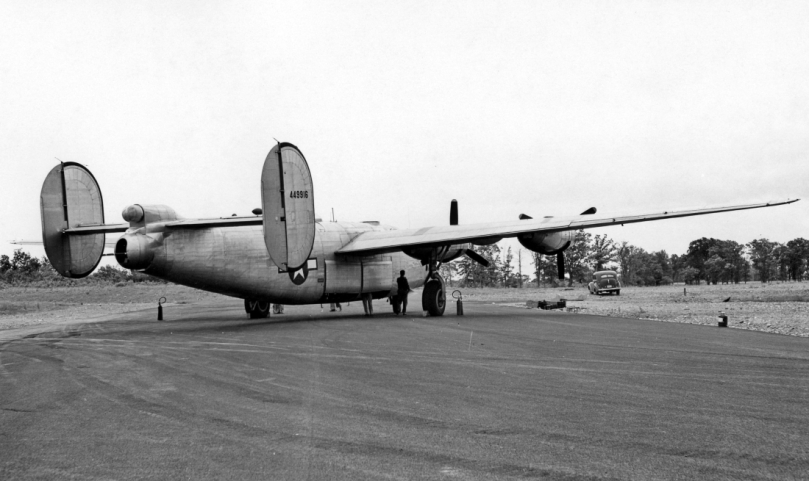
(The only XB-24Q.)
The lone XB-24Q was originally a standard B-24L Liberator (serial number 44-49916) bomber which in July 1946 was delivered to the General Electric factory at Schenectady, NY as the testbed for the new A-5 defensive gunnery system. This 20mm gun / radar combination was G.E.’s proposal for Boeing’s XB-47 project which became the B-47 Stratojet. After the trials concluded the XB-24Q was flown to Olmstead AFB, PA and scrapped.
Even these small handful of modified planes were not really desired long-term, as the military’s main objective was to get rid of the Liberator fleet as fast as possible.
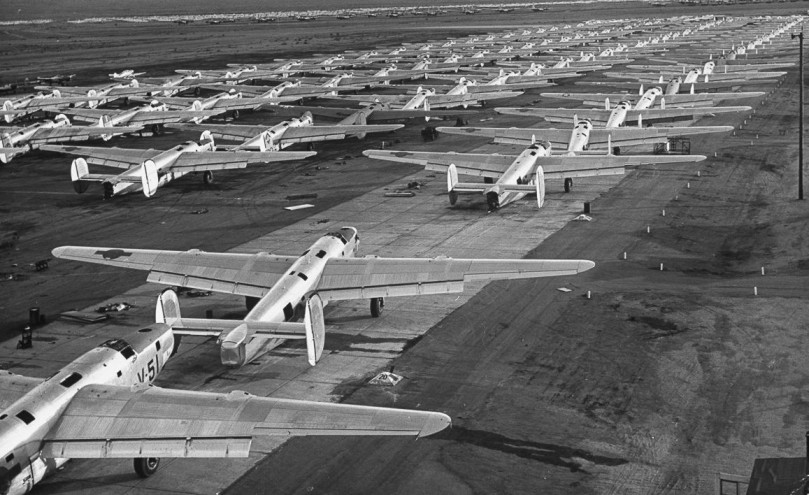
(Endless B-24s at Kingman, AZ for scrap in 1947. Some of these planes had only served several months during WWII, and some not at all, being flown there straight from Willow Run in 1945. The engines, guns, bombsights, and radios were cut out as those were more valuable individually after WWII than the sum of their whole.)
A small number of Liberators were demilitarized and sold into civilian use. But compared to WWII-surplus B-17s far, far fewer B-24s ended up this way. The last known civilian operator was a Bolivian airline in 1975.
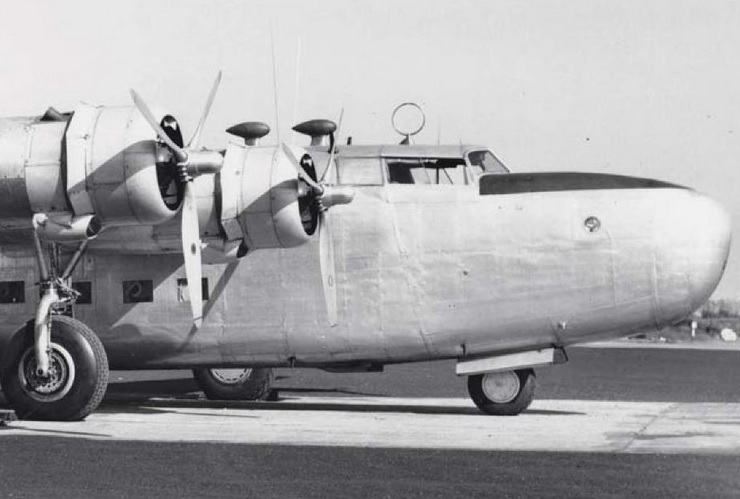
(This B-24 was extensively rebuilt with a new nose and a passenger cabin replacing the bomb bay. It was used as a private plane by Continental Can Company.)
For the most part, the thousands and thousands of Liberators which had been in service in 1945 were already scrapped by the end of 1948.
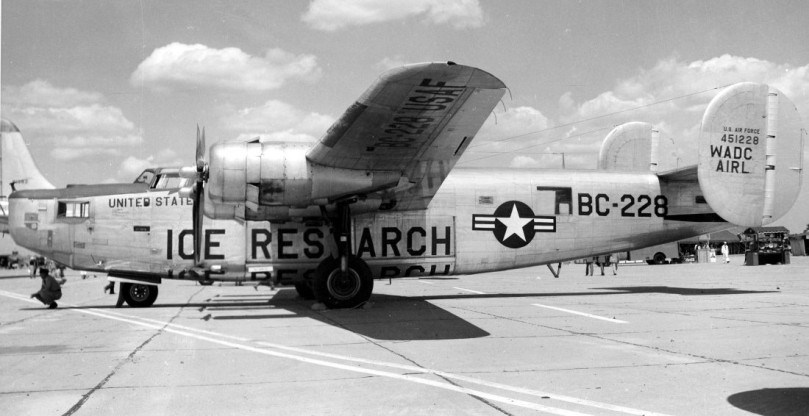
By the start of the Korean War, the plane above was the very last Liberator in the US Air Force. This was originally a 1945-production (serial number 44-51228) B-24M which had never flown a combat mission during WWII. After the war ended, the defensive guns and bombsight were removed and the plane was used as a “hack” transport. It was then heavily modified by the Wright Air Development Center, OH to an ice research plane for the Aeronautical Icing Research Center in Berlin, NH. This was a joint effort of the US Air Force and National Weather Service.

This plane, designated EZB-24M in the US Air Force, was last flown on 6 May 1951. With that, the Liberator story in the United States came to an end.
in the Commonwealth
Great Britain, Canada, Australia, and later South Africa all received B-24 Liberators via Lend-Lease during WWII. Lend-Lease is often misunderstood today. The term was not two separate concepts; rather; the free “lend” was for WWII’s duration and the interest-charged “lease” part kicked in at a preset time after Japan surrendered.
For recipients of Lend-Lease warplanes in September 1945, the options were 1) to begin paying money, 2) return the aircraft back to the United States at the recipient’s expense, or 3) to simply destroy it. In almost all cases, the lease costs were prohibitive and the return expense would have been greater than the airplane’s entire value. Most were therefore just discarded, often close to wherever they had happened to be when WWII ended.
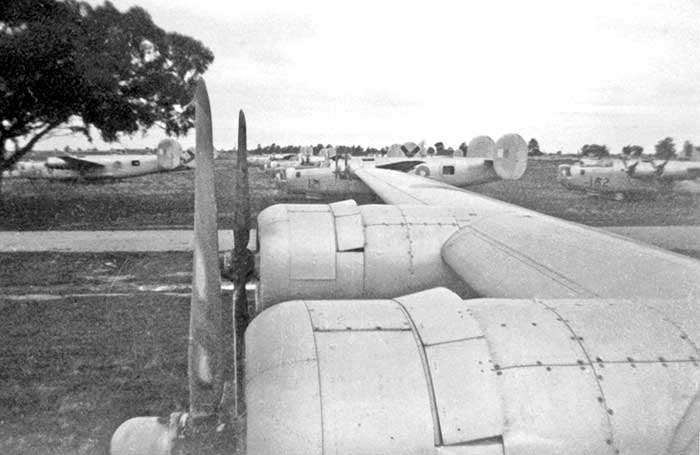
(RAF / RAAF Liberators awaiting scrapping at Tocumwal, Australia after WWII ended.)
South Africa already had no Liberators by the autumn of 1945. Great Britain and Australia got rid of the last of theirs by early 1946 and Canada followed suit.
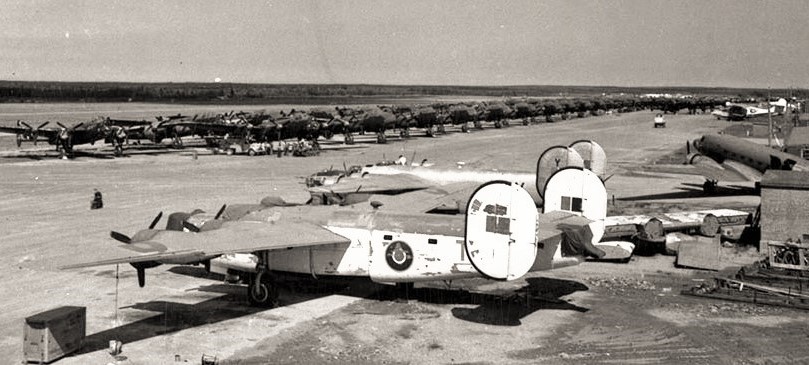
(A pair of discarded Liberator GR.Mk.VIs (B-24Ds fitted with British ASW equipment) at Scoudouc, New Brunswick in late 1945. The other aircraft are Lancaster strategic bombers, a Dakota (lend-leased C-47 Skytrain), and a Casco (Canadian PBY Catalina) in the upper right.)
A very few Liberators did continue to serve for a little while in Canada after WWII but for the reasons mentioned above, their numbers were few.
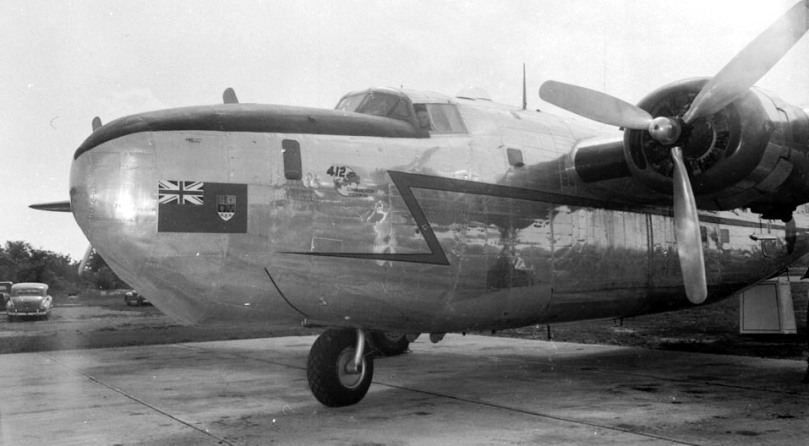
(This Liberator C.Mk.VI (lend-leased B-24D bomber converted to a passenger plane) was still active with the RCAF’s 168th Squadron in Ontario during the summer of 1948.)
A few non-Commonwealth WWII allies briefly operated Liberators after the war. The Netherlands flew a squadron of B-24s out of the Dutch East Indies in late 1945 / early 1946, and Brazil operated a C-87 Liberator Express until 1955. There was little enthusiasm in Washington, DC for exporting surplus B-24s and even less at Convair (Consolidated and Vultee having merged during WWII) for offering parts and technical support abroad.
part II: nationalist China / Taiwan
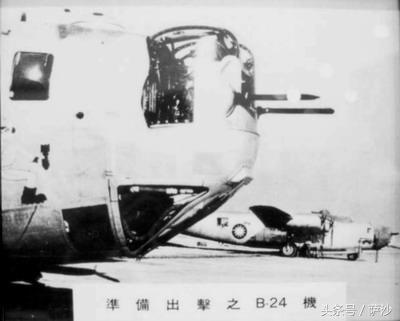
During WWII the ROCAF (nationalist Chinese air force) had a bomber force limited to twin-engined tactical types, mostly obsolete and few in number. In March 1943, the US Army’s 308th Bombardment Group relocated to Kunming in the far southwestern Yunnan province, and began operating B-24 Liberators from there.
During 1943 Generalissimo Chiang Kai-shek requested the USA assist China with establishing a true strategic bomber force. There were tentative plans to transfer in situ all the B-24s of one US Army Liberator unit already in China – most likely the aforementioned 308th Bombardment Group, which was flying B-24D Liberators out of Hsinching (airbase “A-1” in WWII US Army nomenclature) and Kwanghan (“A-3”). Both bases were in central China. At that time, the 308th had 40 fully-airworthy B-24Ds.
However in October 1943, the 308th self-relocated to Raj India to convert to the B-24M model. One B-24D was left behind and “theatre transferred” to the ROCAF as an introductory example of the B-24 pending further later aircraft. The Chinese were given no prior training on it and, not surprisingly, barely used this Liberator.
In early 1944, personnel (about 30 full flight crews plus some added crewmen) of the ROCAF’s 8th Composite Squadron were sent to the USA to be trained on the B-24M Liberator. This squadron previously had a mixed bag of Ilyushin DB-3 and Martin B-10 twin-engined bombers plus the lone B-24D. At the same time the USA agreed to provide China with 54 B-24M Liberator bombers, a number equal to three US Army squadrons or ¾ of one WWII American bomber group.
This training completed in June 1944 and by July, the first batch of ROCAF B-24Ms had made it to Raj India. All were factory-fresh planes made at the Consolidated factory. However here the project stalled, due to squabbling in China on where to base the strategic bombers, and lack of planning and preparation for ground support. For 10 months the Chinese B-24 unit sat on the ground in India, doing nothing.
Only in late May 1945, after Germany and Italy had been knocked out of WWII and the Allies already had commanding air superiority in the Pacific, were the planes released to begin their trek over “The Hump” (Himalayas) to Chinese soil. The B-24Ms were flown in groups of eight to staging bases in Yunnan and Sichuan, their final home base not yet determined.
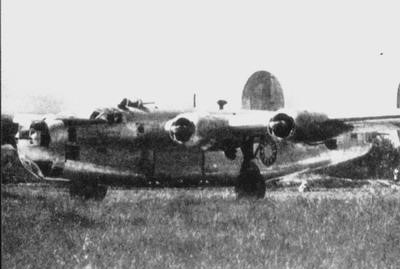
In July 1945 all of the planes were in China awaiting assignment, however several weeks later Emperor Hirohito broadcast Japan’s intent to surrender and the USA forbade further strategic missions to the actual end of WWII on 2 September. Therefore the Chinese B-24s saw no combat during WWII.
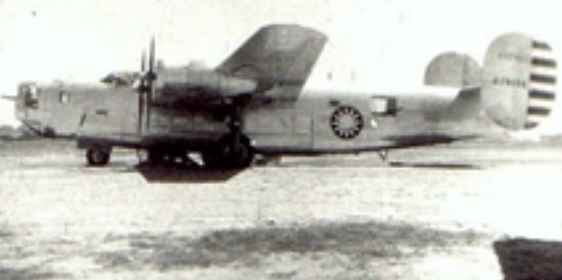
(ROCAF B-24 Liberator at Beijing in 1946. During WWII the city was renamed Peping by the Japanese who used it as the “capital” of Wang Jingwei’s puppet regime. Nationalist rule was brief: Japanese troops departed in September 1945 and the city fell to Mao’s communists in January 1949.) (photo by Tom Nallen)
The civil war against Mao’s communists restarted as WWII ended and the ROCAF now began to use their B-24s in combat.
basing the Liberators
The first “central base” for ROCAF B-24 Liberator operations was a former Imperial Japanese Army airbase near Shanghai on the northeast coast. During WWII it had housed the IJAAF 48th Sentai’s Ki-43 “Oscar” fighters and a detachment of Ki-21 “Sally” tactical bombers. It had a runway suitable for the Liberator. The runway issue was to become a defining factor for the ROCAF’s B-24 bombers. Despite the many airbases built by China, Japan, and the USA in China during WWII; not all were suitable for the B-24.
An “empty” Liberator (no gun crews, no bombs, minimal fuel) needed about 2,000′ of paved runway to take off. With a full combat load, this grew to 3,520′ of paved runway or over 5,000′ of hard dry turf. To land, the B-24 needed between 2,365′ -2,850′ of paved runway or 3,300′ – 4,040′ of grass. The runways had to bear a 33 – 35 ton weight moving over 100mph at takeoff.
The Liberator itself was 36 yards wide and 23 yards long, which took up a lot more real estate on the apron and taxiway than single-engine types in the mid-1940s ROCAF such as the P-51 Mustang.
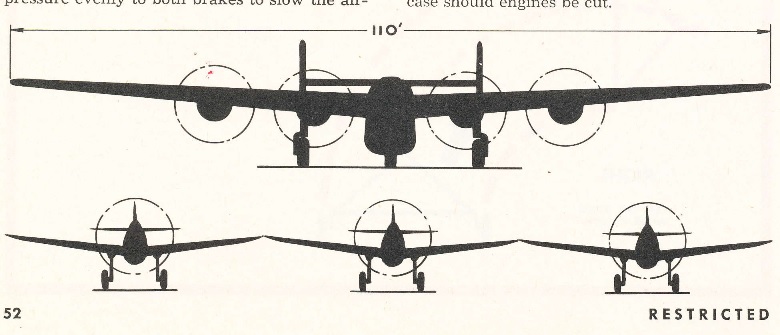
(A snippet from the B-24’s WWII pilot manual, showing how the plane on the ground took up as much room as three P-40 Warhawk fighters together.)
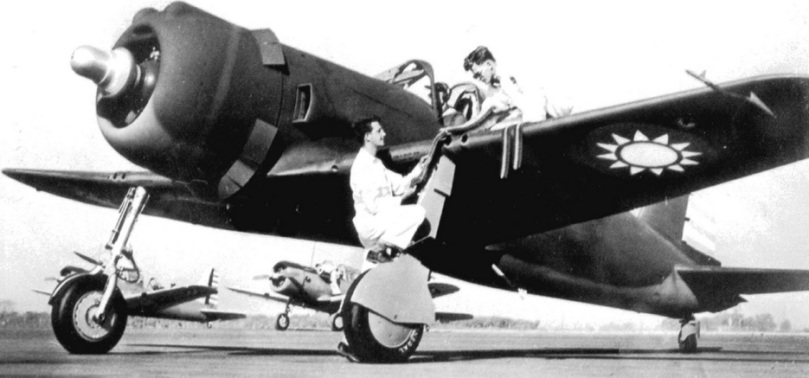
(The P-66 Vanguard fighter had a total wingspan only 29 inches less than the size of a Liberator’s tail, and was only 6′ longer than the length of the B-24’s bomb bay area. P-66s which survived WWII saw little use during the Chinese Civil War. Some were still crated up from the Vultee factory as late as 1947.)
The US Army used ANF-28 100 octane aviation fuel with the B-24 Liberator during WWII. (The engines would not function with less than 91 octane.) During the Chinese Civil War, this was not an afterthought as the country’s petroleum infrastructure was oriented towards low-octane gasoline and diesel fuel. (The Soviet Union experienced similar difficulties with some Lend-Leased warplane types during WWII.) To fully exploit the B-24’s bombing ceiling, each crewman needed an A8 oxygen mask. These took ten G-1 cylinder fills every mission. Again, this was not an afterthought. Some of the ex-US Army airbases in China had left-behind oxygen infrastructure, but for the most part WWII-vintage ROCAF and ex-Japanese WWII airbases used during the Chinese Civil War were still geared towards flying open-cockpit types.
A (possibly exaggerated) story of the B-24’s early days in the ROCAF was confusion and frustration over the small red and white lights under the tail gun. During WWII missions over Germany the white light lit up when the bomb bay doors opened and the red when bombs were being released, to warn other bombers in formation not to cross under. At least some of the Chinese aircrews were apparently not briefed on their intended role.
In any case, by late 1946 the Liberators were active out of Shanghai and elsewhere. In northern China, Nan Yuen airbase hosted B-24s. This airbase near Beijing had been the home of both Imperial Japanese Army and Navy twin-engined types during WWII.
In Yunnan (the part of China which bordered Burma and French Indochina), Yunnani airbase was refurbished, having been abandoned by the US Army 1½ months before WWII ended in 1945. Also in Yunnan, Kunming airfield was handed over by the US Army several months after V-J Day. Originally home the warlord Tang Jiyao’s private air force, during WWII it was one of the original B-24 bases so it was obviously suitable.
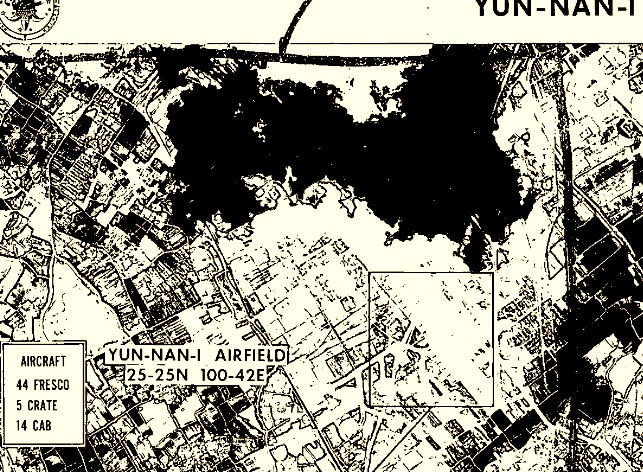
(A Vietnam War-era image of the ex-US Army WWII airbase at Yunnani, by then home to 44 Chinese MiG-17 jet fighters, 14 Li-2 transports, and 5 Il-14 passenger planes.)
In central China, Shwangliu housed US Army P-47 Thunderbolts and P-38 Lightnings during WWII. The 33rd Fighter Group departed when WWII ended and turned the base over to the ROCAF, who found it suitable for B-24 Liberators as the Americans had also used it as a layover for B-29s. (As of 2020, Chengdu’s modern airport sits on the site.) Nearby was Kwanghan, the aforementioned “A-3” of WWII, which was obviously suitable. Also in this region, Qionglai was a B-29 Superfortress base during WWII so its runways would have no problem with the B-24. (As of 2020, both Kwanghan and Qionglai are still active PLAAF airbases.)
Qingdao, north of Shanghai on China’s seaboard, had been a Japanese airbase throughout WWII. When the ROCAF took over the base after WWII, it was repaired and made ready for B-24s.
Between 1946 and the end of 1948, the nationalists suffered defeat after defeat and Mao’s territory swelled from its original “homebase” of north China, to much of the country by early summer 1949. The ROCAF thus had to re-base the B-24s in safer areas, namely islands off the mainland.
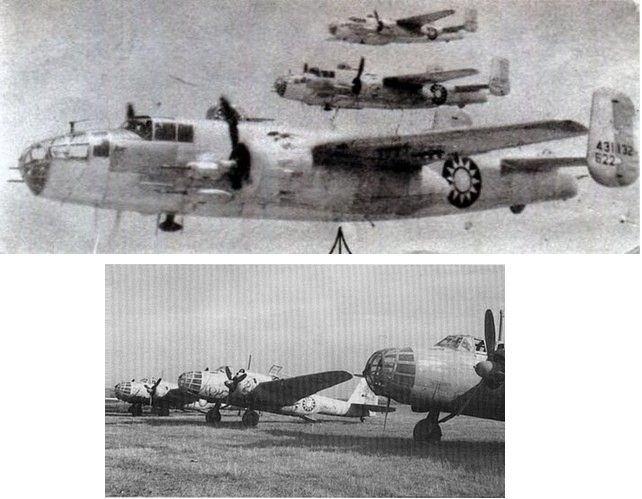
(Two of the twin-engined bomber types of the ROCAF during the Chinese Civil War, the B-25 Mitchell and Ki-48 “Lily”. Tactical bombers offered probably as much, if not better, returns than the big four-engined Liberators. Ex-Japanese bombers were mostly gone by 1949 but the Mitchell served on longer in Taiwan.)
Ting-hai was a minor Japanese airbase on the Zhoushans during WWII. The Zhoushans are small islands offshore of Ningbo. During WWII, Ting-hai was mostly used by single-engine Japanese types but now it was expanded, as its location was highly strategic: combat areas around Wenzhou, Shanghai, Hangchow, and Ningbo were put into twin-engine bomber range (and in some cases, single-engine fighters) while all of Manchuria and northern China was in range of the four-engine B-24s.
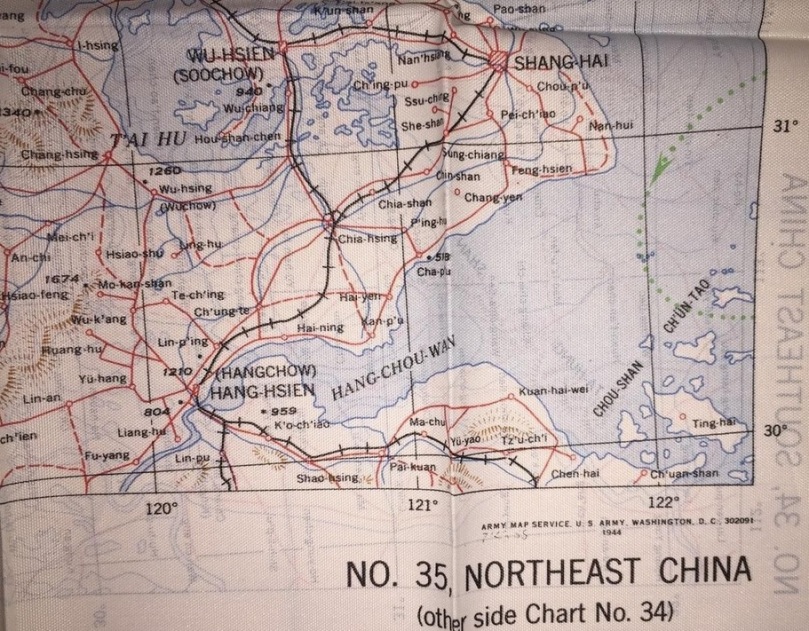
(A WWII US Army map showing Ting-hai in the lower right. “Chou-Shan” was an incorrect transliteration of Zhoushan.)
Meanwhile far south, emphasis was put on the big island of Hainan. During WWII the Imperial Japanese Navy built an airbase at Samah, Hainan (today, the southernmost extreme point of the PRC) for the 901st Kokutai’s A6M “Zero” fighters. Now the ROCAF spent a large sum to enlarge the runway for fully-laden B-24 Liberators. This completed in January 1950 and was a waste, as Samah was overrun by the communists in May.
By the end of 1948 nationalist power was already coalescing on Taiwan, and this became official in 1949 when the nationalist government relocated there. Japan had ruled Taiwan from 1895 to 1945 and during WWII established a massive military presence there.
IJAAF Matsuyama in the island’s north housed a Ki-61 “Tony” fighter unit during WWII. In the late 1940s it was renamed Chiang Kai-shek Airport, and was enlarged into a dual civilian / military facility. (In 2020 it is Taoyuan International Airport.)
In the island’s south, Okayama was an Imperial Japanese Navy facility with two long runways and an aircraft repair facility. In October 1945 it was taken over by the ROCAF and renamed Gangshan. (As of 2020 it is still a ROCAF airbase.) Nearby was the former IJAAF Takao, with a single runway which was also enlarged for B-24 operations.
B-24 operations during the Chinese Civil War
Although they had a decent number of Liberators on hand, the ROCAF’s B-24s did not make much of an impact in comparison to the type’s American service in WWII. One factor was simply geography: China is a huge country and the “frontlines” between 1945 and 1949 often resembled a patchwork of rural communist gains interlacing isolated “pockets” of nationalist territory. The B-24s were just spread too thin.
Many of the ROCAF B-24 missions caused an impressive level of destruction but did not really dent the communist’s warmaking abilities much. For example in May 1949, three B-24s flying out of Qingdao bombed Shenyang, destroying 170 buildings in the city. Few were of industrial importance.
In October 1949, B-24s flying out of Taiwan assisted in the successful repulsion of a communist amphibious assault against Kinmen island; one of the few offshore holdings the Taiwanese government continues to own to the present time.
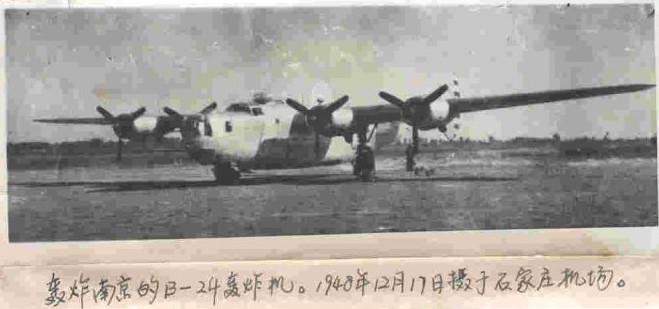
On 25 January 1950, eight months after Shanghai fell and at a time when the war was effectively already lost, the ROCAF launched 17 B-24 Liberators out of Ting-hai against the city. Numerically this was one of the largest single bomber formations of the Chinese Civil War. On 6 February, this was followed up by a hodge-podge of twin-engined B-25s and several ex-Japanese twin-engined bombers. The two raids killed several hundred civilians but accomplished little else.
Although the sinking of the cruiser (described below) is more famous today, perhaps the single most effective ROCAF B-24 raid came on 20 February 1950. A wave of B-24s out of Ting-hai targeted Nanking’s electrical grid, successfully destroying it and knocking the city into darkness.
Several months later the communists made a successful amphibious assault of the Zhoushans, eliminating Ting-hai as a B-24 base.
to sink a cruiser
On 19 May 1948 the UK transferred the WWII cruiser HMS Aurora to the nationalist navy, the Republic Of China Navy (ROCN). This was China’s first “new” cruiser since before the 1930s Sino-Japanese War and along with the small, obsolete ROCS Yat Sen one of only two cruisers after WWII. The ship was renamed ROCS Chungking and immediately made the flagship of the ROCN when it arrived at Shanghai in August 1948. During the winter of 1948 – 1949 ROCS Chungking provided offshore fire support for nationalist troops near Tashan.
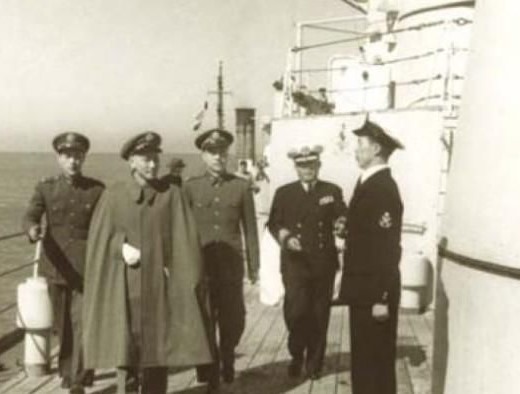
(Chiang Kai-shek aboard ROCS Chungking.)
On 25 February 1949 there was a mutiny aboard the cruiser while pierside in Shanghai and the ship defected to the communist side. The captain immediately set sail and arrived 25 hours later at Yantai which was in communist hands. The communists retained the name but spelled it slightly differently, Tchoungking.
Generalissimo Chiang Kai-shek was infuriated by the mutiny. The ship was an irreplaceable loss, as the USA refused to provide warships larger than destroyers as military aid and there was no way a cruiser could be afforded outright. At the time of the mutiny, ROCS Chungking was storing gold bullion from Shanghai’s financial district, under the impression that this was safer than bank vaults. Beyond that there was the political humiliation of having the ROCN flagship switch sides.
Chiang ordered the ship’s destruction by air, at any detriment for other ongoing bomber requirements. The problem was finding Tchoungking to bomb it, as the communists kept moving it around. Leaving Yantai, Tchoungking was spotted at sea near the Shandong peninsula, and then again pierside in Yantai, and then pierside in Paiyinshan. Coordination in the ROCAF was not great then and each time P-38 or P-51s saw the ship, it had moved again by the time B-24s could be assembled for a strike package.
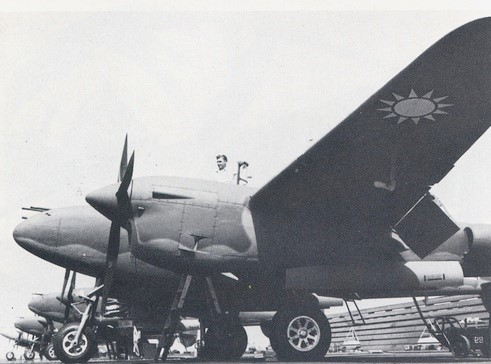
(P-38 Lightnings were often used as “target-finders” for the ROCAF’s B-24s during the Chinese Civil War.)
After 10 months, Tchoungking‘s luck ran out. The cruiser was spotted repeatedly by sustained P-38 Lightning recon missions in February 1949. On 18 March 1949 a strike package of four B-24 Liberators out of Qingdao attacked the ship and reported that they had damaged it pierside at Hulu. The next day seven B-24s bombed the ship at Taku near Tianjin and several hours later, another wave of eight B-24s bracketed the ship with more 500 lb bombs, causing Tchoungking to capsize.
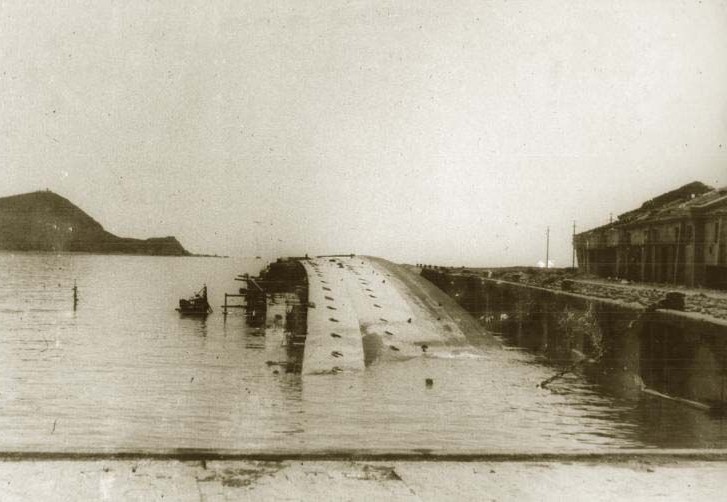
In February 1950, a team of Soviet navy experts studied the cruiser, which had laid capsized for 10½ months. They advised the communist navy (the PLAN) that the ship was salvageable and that the USSR would assist. Beginning in early April, the wreck was slowly righted, a process which took until 13 June 1951. On 18 June 1951 the hulk was towed to a drydock at Dalian.
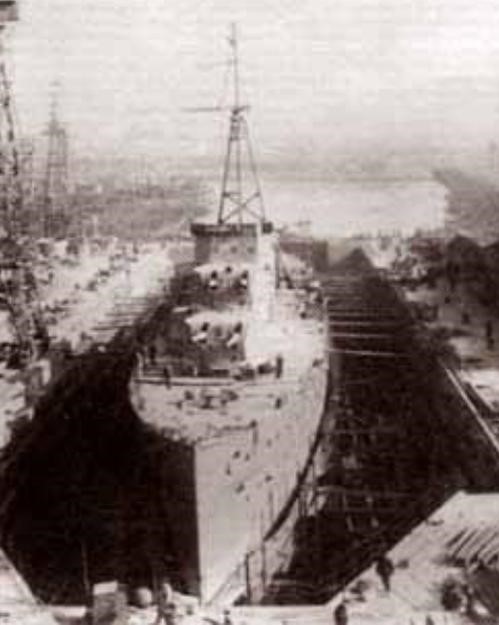
The Soviets advised that it would take 4 years to restore the cruiser, at a cost equal to roughly 50 patrol boats. To the Chinese communists, which were still frequently engaging the ROCN in offshore gunboat duels, four dozen new patrol boats were a more attractive asset than one WWII cruiser.
The Chinese communists also discovered that Soviet “assistance” was perhaps not all it was cracked up to be. During 1951 – 1952 the Soviet salvage team stripped the drydocked Tchoungking of any repairable WWII British optics, gunfire control systems, radios, navigation gear, and light AA guns.
In 1955 repairs were abandoned. Some of the engine room machinery was removed and used in a local factory. Tchoungking was re-roled as an inport administrative barge.
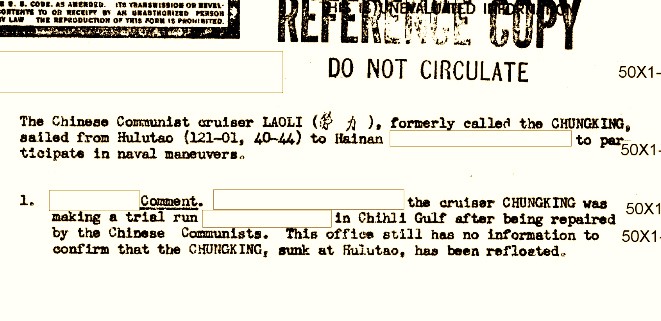
(This is a January 1952 CIA intelligence assessment of the cruiser, probably second- or third-hand reporting of data provided by the KMT in Taiwan . It is unknown what “Laoli” was, as there was no known warship of that name, and it certainly was not the cruiser in question.)
In November 1959, the ship was towed to Shanghai and renamed Huanghe. There were plans to restore and convert the ship into some sort of support vessel, but these did not pan out.
In 1964, Huanghe was towed to Tianjin. Here the ship was decommissioned and fully disarmed. The hulk was donated to the government-owned Tianjin Bohai Oil company and renamed Beijing. The oil company used Beijing as a floating dormitory for employees. Several western naval publications correctly noted the name change but incorrectly stated that Beijing was still in naval use. By the 1980s Beijing was falling apart at the seams and was scrapped sometime around 1990.
This was the most famous operation by the ROCAF B-24 Liberators, but in the end it did not alter the balance of power much. It was also the last major B-24 mission flown out of Qingdao, which was overrun by the communists about nine weeks later.
ROCAF Liberator Expresses

(artwork by Li Su-Pin)
The nationalists obtained three C-87 Liberator Express transports from departing US Army units in early 1946. These were quite useful to the ROCAF, far out of proportion to their number, especially in 1949 when the evacuation off the mainland began in earnest. In April 1949 a C-87 made the last nationalist departure of any type out of Nanjing airbase just before it was overrun. By 1951 there were still two in service, and the last was not retired until 1956.
communist B-24s

Mao’s forces managed to get their hands on at least three Liberators. One was either a defection or ground capture in mid-1946, another was a defection in December 1948 (the aircrew initially intended to bomb a building where Chiang Kai-Shek was thought to be staying but could not find it), and finally a Shanghai-based B-24 which defected in February 1949. The PLAAF used B-24 Liberators in combat, in one case reportedly destroying a ROCAF B-24 on the ground. The last B-24 in communist service was retired in 1952.
end of the road for the B-24 in Taiwan

(Josef Stalin hoped to have the La-9 “Fritz” ready for the 1945 invasion of Manchuria but it did not enter service until after WWII had ended. Along with the La-11 “Fang”, the La-9 was the last generation of Soviet piston-engined fighters. These are forgotten today but were formidable designs of an era coming to an end. Some were provided to the PLAAF in China near the end of the Civil War.) (artwork via Wings Palette website)
After the January 1950 air raids against Shanghai, the USSR stationed a unit of the then-new MiG-15 jet fighter near the city and also stepped up deliveries of fighters to Mao’s air force.

(Along with its rival, the F-86 Sabre, the MiG-15 was a legend of the Korean War and totally outclassed the WWII-vintage piston-engined bombers of the ROCAF in 1950.)
On 2 April 1950, a P-51 Mustang was shot down by Soviet fighters over Shanghai, and several days later a P-38 Lightning was also shot down. Despite the new danger, the ROCAF decided to persist with B-24 bombing missions against the mainland.
On 11 May 1950, a pair of B-24 Liberators were shot down by Soviet MiG-15s near Shanghai. With the B-24 numbers already depleted, it was decided not to attempt any more bombing missions where jets might be present.
By the end of the Korean War in 1953, not only were the lumbering B-24 Liberators vulnerable, but also the piston-engined fighters the ROCAF used as “target finders”. In early 1954, three ROCAF P-47 Thunderbolts were shot down by Chinese MiG-15 jets and that marked the unofficial end of using piston-engined fighters over the mainland, although a P-47 did manage to shoot down a Chinese MiG-15 later that year.
With no bombing role remaining, surviving B-24s were used as “infiltration planes”, flying dangerous solo missions to parachute intelligence agents onto the mainland, and to supply nationalist troops who had been marooned on the mainland in 1949 and were fighting a desperate (and doomed) low-scale guerilla war in the 1950s. Other WWII planes, including the PBY Catalina and C-47 Skytrain, were also used for these missions. On 22 June 1954, a B-24 conducting an airdrop near Nanchang was engaged by a La-11 “Fang”, which it drove off with .50cal gunfire.
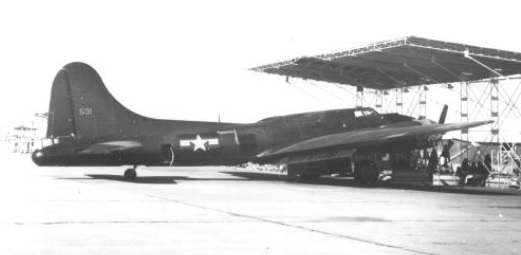
(This black WWII B-17 Flying Fortress, wearing bogus US Air Force insignia, was owned by the CIA’s Taiwanese front company Civil Air Transport and operated on behalf of the ROCAF. Shown here at Clark AFB in 1957, several B-17s like this supported insurgents in Tibet and the “lost nationalist army” in Burma.)
A handful of B-24s were still flying in the mid-1950s but their time in Taiwan had come and gone. Starting in 1952 the type was withdrawn from service. The last Taiwanese B-24 Liberator was officially retired in 1956.

(artwork via Wings Palette website)
part III: India
If the story of the B-24 in Taiwan is interesting, the plane’s tale in India is almost unbelievable.
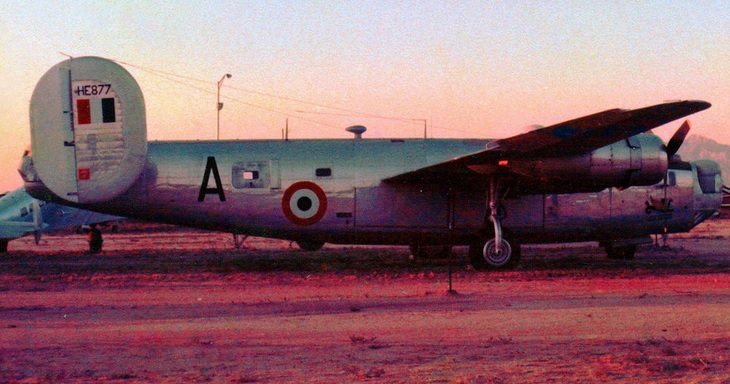
India became independent on 15 August 1947. Later that year, India fought the first of what would be several wars against Pakistan where it was noted that the Indian air force lacked a strategic bombing ability. The USA offered WWII-surplus B-25 Mitchell twin-engined bombers which were rejected as unsuitable for the strategic mission. The UK offered to sell WWII-surplus four-engined Lancasters, at a price which India considered too high.
After the 1947 Indo-Pak War, Hindustan Aircraft, Ltd or HAL (today Hindustan Aeronautics) suggested another solution, which on its face seemed almost too absurd to even consider.
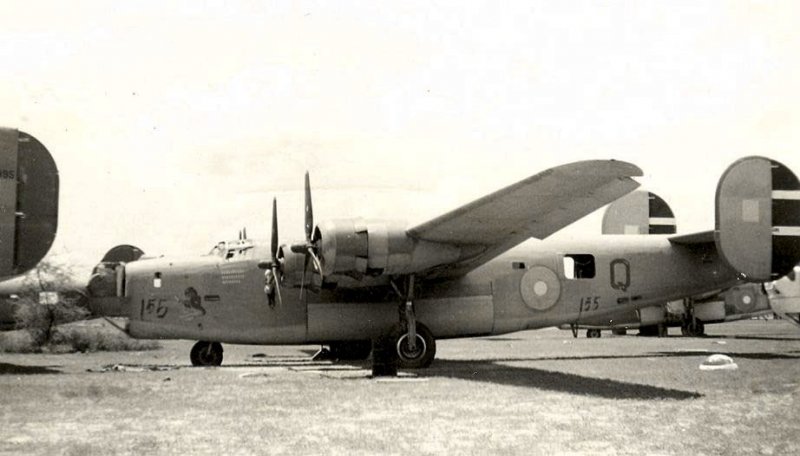
(A “destroyed” ex-RAF lend-leased Liberator at an abandoned airbase in India several years after WWII. This B-24 had the guns removed and the nose windshield broken out but otherwise looks largely intact.)
As mentioned earlier, the terms of WWII Lend-Lease required subject warships and warplanes to either be paid for, returned, or destroyed. For warplanes almost invariably the last option was chosen by the British.
As this was such an unprecedented situation for RAF squadrons, there was no set procedure or “finish line” to determine exactly when an airplane was legally “destroyed”. And likewise on the other end, there was not really any hard criteria set forth by the USA to delineate when a lend-leased aircraft ceased to be one. All around the world, RAF units were more or less each left to their own judgement and in turn, the USA accepted their reports without a whole lot of fuss, checked off a serial number as “destroyed”, and moved on.
Not surprisingly, the end result varied. Sometimes it was not in question when lend-leased planes were run over with bulldozers or dumped into the ocean. An “average” job might entail removing any weapons, holing the wings and fuselage with a fire ax, busting up the cockpit, and pouring sand into the engines. Sometimes even less was done.
In late 1947 it was noted that a WWII airstrip at Chakeri in Uttar Pradesh (north-central India) had a huge park of B-24 Liberators which had taken very little abuse during their lend-lease writeoff two years previous, and might actually be restored to use.
HAL already had a decent reputation, and in what was then derisively called the “former colonial world”, was probably an aerospace leader in the late 1940s. During WWII HAL had overhauled PBY Catalina naval aircraft and various types of transports, and was the first Asian licensee by Douglas to overhaul DC-3s. So the company’s voice carried some weight and the project was approved.
HAL originally planned to disassemble the B-24s at Chakeri and haul them by railroad to the company factory in Bangalore, a 932 mile journey. It was determined that no rolling stock could handle the big Liberators without disassembling them to an impossible degree, so they would have to be patched up on-site just enough to make a 1-way trip south, and then flown to Bangalore.
A joint team of HAL employees and Indian air force mechanics began picking over the dozens of bombers at Chakeri, stripping parts off hopeless cases to repair other planes. This was not a simple task as often, the same part was missing or broken over many airframes.
Since nobody in the Indian air force was qualified on the B-24, a team was sent to the USA to discretely recruit WWII veterans to fly the planes. This effort failed as the American vets demanded exorbitant wages in excess of the whole Liberator project’s budget. It is difficult to blame the Americans as they were being asked to travel halfway around the world and fly a half-crippled plane which had been sitting outside for 2½ years.
The solution was found in a young airman named Jamshed “Jimmy” K. Munshi. A HAL test pilot, Munshi volunteered to not only fly the B-24s to HAL but to do so for free. Munshi had never flown a four-engined airplane of any type, let alone a B-24, but by studying abandoned WWII manuals he felt confident.
Starting in early 1948, the bombers were flown one-by-one, all by Munshi. A total of 42 B-24 Liberators plus two C-87 Liberator Expresses were delivered to Bangalore without a single airframe loss.
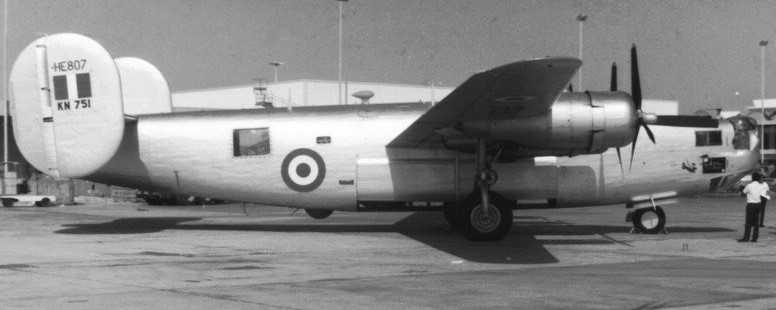
At HAL, every Liberator was thoroughly inspected with any suspect part replaced, and all brought to a common standard. India regarded each refurbishment as so extensive to warrant being a “new” airplane and an entirely new serial number was issued. Jimmy Munshi personally flew each one as a final act.
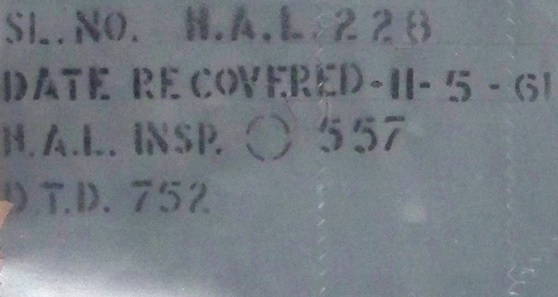
By November 1948, enough Liberators were ready to begin issuing them to squadrons. Of the 42 available airframes, it was decided to create two strategic bomber squadrons (the 5th and 6th) each with 16 Liberators, plus 3 planes assigned to the 16th squadron for training and the other seven aircraft held in reserve. The whole force was up and running in 1951.
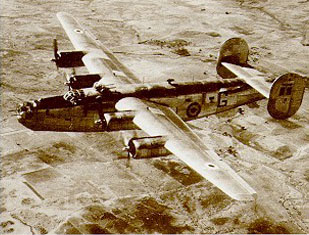
(B-24 Liberator flying over central India during the 1950s.)
Regarding the USA, there was nothing specifically “wrong” with what India had done as both the UK and the United States had accepted the planes destruction at the end of WWII. None the less, now in the Cold War, there was unhappiness at this aviation miracle. The State Department, which at that time favored Pakistan, was not thrilled and even less so was the Pentagon. Here, there was no battlefield concern as the B-24s obviously presented zero threat to the American military, but the US Air Force absolutely could not believe that multiple squadrons worth of heavy bombers had magically been restored from the scrap heap. Rather, it was felt that during the mass B-24 scrapping of 1946 there had been some sort of illegal diversion in Arizona. The USAF was determined to investigate to identify a suspect and more importantly, figure out if any WWII surplus of a more serious nature had been stolen.
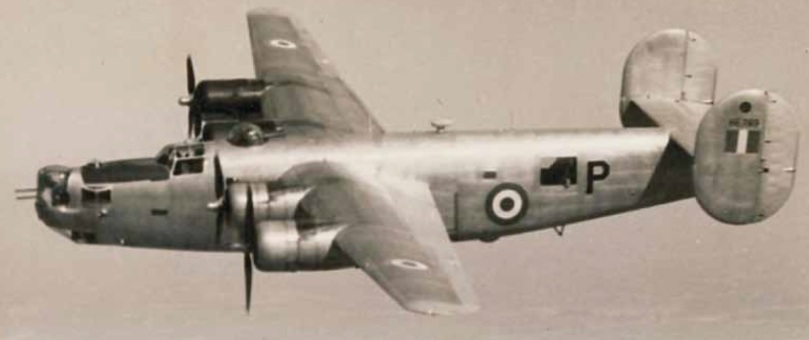
(B-24 Liberator of the 5th Squadron in flight during the 1950s.)
India invited an American team to visit the HAL factory where they were shown, step by step, how the B-24s had been restored in 1948. An American pilot was allowed to fly one. Satisfied, the USA’s interest in the Indian Liberators ended.
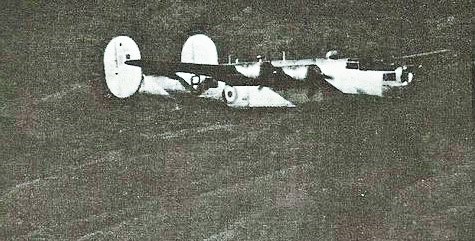
(Indian B-24 during the 1950s.)
There was at least one crash but surprisingly, the “miracle” B-24s restored by HAL had a better accidents-to-airframes ratio in the 1950s than either the USA or Britain during WWII.
Regarding the two C-87 Liberator Expresses, one was refit as a high-altitude photography plane and took the first high-detail photos of Mt. Everest’s summit.
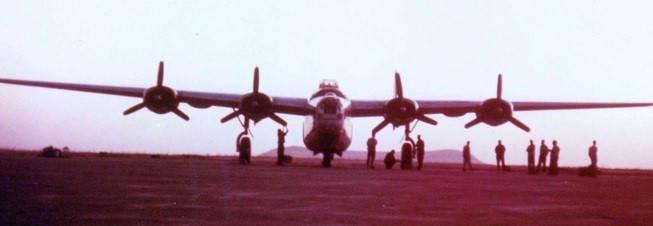
(Indian B-24 at Pune in the early 1960s.)
The Indian air force realized in the 1950s that however amazing of a feat by HAL, the United States was correct in its 1945 assessment of the B-24 being obsolete as a strategic bomber. It was only ever viewed as a stop-gap. In 1957, the 5th Squadron converted to Canberra jet bombers.
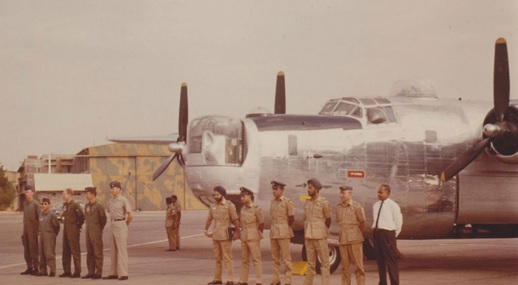
(6th Squadron B-24 during the 1960s.)
Meanwhile the 6th Squadron retained its Liberators, now re-roled as maritime search and strike planes. The WWII belly ball gun was replaced by a short-range air-to-surface radar, and the bomb bays were modified to carry either normal bombs or depth charges.
During the December 1961 annexation of Portuguese Goa, the 6th Squadron’s B-24s flew search patterns to guard against Portuguese warships approaching the Indian flotilla undetected. On the short conflict’s last day, they dropped leaflets over Goa urging a Portuguese surrender.
During the 1965 Indo-Pak War, the 6th Squadron’s Liberators undertook anti-submarine patrols outside the range of land-based Pakistani jet fighters. No submarines were found.
Following that war’s conclusion, a decision was made to fully retire the B-24 from all roles. The last was withdrawn from service in 1969, ending the Liberator story worldwide.
postscript
While the nationalist Chinese and Indian uses of the B-24 remain quite interesting, the main part of the Liberator’s post-WWII story is the amazing speed with which the United States discarded the type. In under two years, it went from being one of the most populous things in the world’s skies to simply being gone altogether.
A debt is owed to the Indian air force. After the 6th Squadron retired the type, India generously made available the planes for historic preservation by the WWII allies. At least half a dozen B-24s worldwide today in 2020 are “rescues” by HAL in the late 1940s; about half the total remaining of this most-built type.

(One Indian plane was presented to the RCAF. It is shown here alongside a CF-104 Starfighter in West Germany during its journey from India to Canada.)

Reblogged this on Dave Loves History.
LikeLiked by 1 person
Excellent article on a fascinating aspect of post-WWII history. Thank you!
LikeLiked by 1 person
Very interesting write up. It’s so very sad how few of these great aircraft remain today, especially given how many were built. The US must hold the record for destroying one model of aircraft faster than anyone else in the world!
LikeLiked by 2 people
Great article.
The Image of the B-24J that was disarmed for use as a staff shuttle with the odd nose is interesting.
Could the nose be from a B-18 bolo? It looks very similar.
LikeLiked by 1 person
I believe they are different sizes but you are right, it does look like a B-18’s nose.
LikeLike
I didn’t realize that B-24s were the most abundant bomber of WW2 (B-17s always hogged the limelight) or that they were so quickly ditched after 1945. Liked the part about the Indian Air Force and that there was something of a happy ending.
LikeLiked by 1 person
in 1946 a b-24 made an emergency landing at galena park Texas in a field used for residue from the Houston ship channel .one wheel went down in mud. several years later it was still there. My father took a friend and myself to see it and we were allowed go through the plane. I was 11 years old. I still have a vived rememberance of the enterior. The plane eventaully disappeard. I have always wondered what happened to it. Can you find anything on it. Thanks.
LikeLike
I think it would be pretty hard to trace what happened to it, I would imagine it was just hauled off to a scrapyard.
LikeLike
JWH. I enjoyed your expose’ on the post wat B-24. I’m a volunteer at Willow Run’s Yankee Air Museum. We are certainly interested in locating a Ford built B-24. Do you think there are any old B-24’s still lurking out there in India or other locations?
LikeLike
I think all of them have already been given away or scrapped. Probably the only option would be a swap with another air museum.
LikeLike
There aren’t many Ford built 24’s around anymore (in any condition). If you ever get wind of one – let me know.
LikeLike
I spoke to a man from North Carolina who is from India. He wasn’t very hopeful. He thought they had all been scrapped shortly after war’s end. I find it hard to believe. In my dad’s letter home while mailing photos and small papers he distinctly spoke of the planes and how new they were. He called it a “sea” of airplanes & mentioned his sadness of the negotiations on abandoning the aircraft. He was one of the mechanics that took care of the B-24’s & very proud and very attached to them
LikeLiked by 1 person
This is the content this blog is or should be famous for 🙂
LikeLiked by 1 person
JWH1975, great article as always. Just wanted to offer one minor correction, the former Matsuyama Airfield is today Taipei Songshan Airport (same Han characters), which is still a dual-use civilian and ROCAF airbase. Taoyuan International Airport was completed in nearby Taoyuan County in 1979 as Chiang Kai-Shek Airport, and was renamed in 2006.
Thank you for these fascinating reads, can’t wait to see more.
LikeLiked by 1 person
thank you for the correction!
LikeLike
[…] https://wwiiafterwwii.wordpress.com/2020/06/29/the-last-liberators/ […]
LikeLike
There’s one RAAF survivor, it’s fuselage escaped the scrappers, and a wing (with combat damage) was came from Alaska. It’s being restored to a very high standard. Alas, spar corrosion has ruled out an airworthy job, but there’s talk of it being taxiable. Personally, I think the RAAF should have refurbished the Lend Lease B-24s rather than licence building Avro Lincolns
LikeLiked by 1 person
I always thought a handful might have made decent COIN types into the 1950s and 1960s.
LikeLike